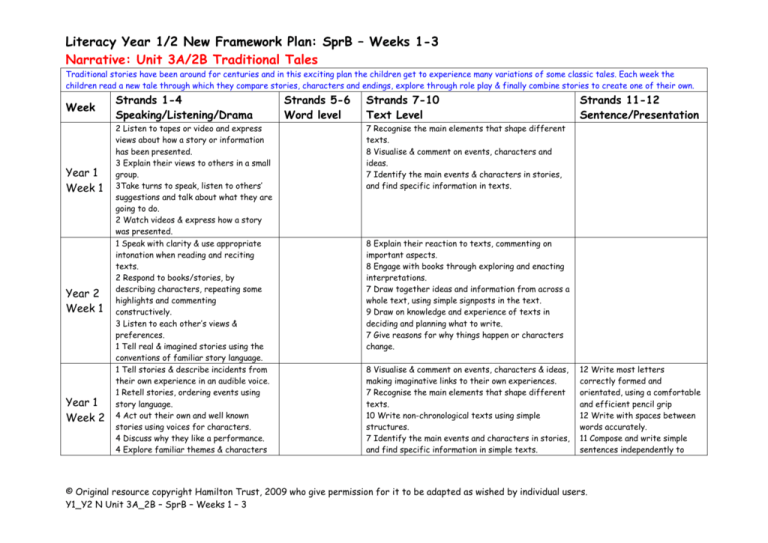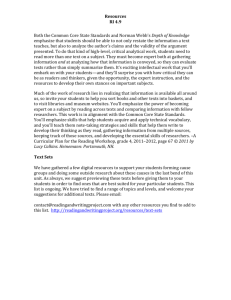Narrative 1 Text Resource 1
advertisement

Literacy Year 1/2 New Framework Plan: SprB – Weeks 1-3 Narrative: Unit 3A/2B Traditional Tales Traditional stories have been around for centuries and in this exciting plan the children get to experience many variations of some classic tales. Each week the children read a new tale through which they compare stories, characters and endings, explore through role play & finally combine stories to create one of their own. Week Year 1 Week 1 Year 2 Week 1 Year 1 Week 2 Strands 1-4 Speaking/Listening/Drama 2 Listen to tapes or video and express views about how a story or information has been presented. 3 Explain their views to others in a small group. 3Take turns to speak, listen to others’ suggestions and talk about what they are going to do. 2 Watch videos & express how a story was presented. 1 Speak with clarity & use appropriate intonation when reading and reciting texts. 2 Respond to books/stories, by describing characters, repeating some highlights and commenting constructively. 3 Listen to each other’s views & preferences. 1 Tell real & imagined stories using the conventions of familiar story language. 1 Tell stories & describe incidents from their own experience in an audible voice. 1 Retell stories, ordering events using story language. 4 Act out their own and well known stories using voices for characters. 4 Discuss why they like a performance. 4 Explore familiar themes & characters Strands 5-6 Word level Strands 7-10 Text Level Strands 11-12 Sentence/Presentation 7 Recognise the main elements that shape different texts. 8 Visualise & comment on events, characters and ideas. 7 Identify the main events & characters in stories, and find specific information in texts. 8 Explain their reaction to texts, commenting on important aspects. 8 Engage with books through exploring and enacting interpretations. 7 Draw together ideas and information from across a whole text, using simple signposts in the text. 9 Draw on knowledge and experience of texts in deciding and planning what to write. 7 Give reasons for why things happen or characters change. 8 Visualise & comment on events, characters & ideas, making imaginative links to their own experiences. 7 Recognise the main elements that shape different texts. 10 Write non-chronological texts using simple structures. 7 Identify the main events and characters in stories, and find specific information in simple texts. 12 Write most letters correctly formed and orientated, using a comfortable and efficient pencil grip 12 Write with spaces between words accurately. 11 Compose and write simple sentences independently to © Original resource copyright Hamilton Trust, 2009 who give permission for it to be adapted as wished by individual users. Y1_Y2 N Unit 3A_2B – SprB – Weeks 1 – 3 Literacy Year 1/2 New Framework Plan: SprB – Weeks 1-3 Narrative: Unit 3A/2B Traditional Tales through improvisation & role-play. 2 Listen to stories & express views about how a story was presented. 3 Explain their views to others in a small group, decide how to report the group’s views to the class. Year 2 Week 2 1 Retell real and imagined stories using the conventions of story language. 4 Adopt appropriate roles in small or large groups and consider alternative courses of action. 4 Present part of traditional stories, their own stories or work drawn from different parts of the curriculum for members of their own class. 1 Speak with clarity & use appropriate intonation when reading & reciting texts. 2 Respond to books by describing characters. 3 Listen to each other’s views & preferences, agree next steps to take and identify contributions by each group member. 1 Explain ideas and processes using imaginative and adventurous vocabulary and non-verbal gestures to support communication. 2 Listen to talk by a teacher, remember some specific points & identify what they have learned. 5 Spell with increasing accuracy & confidence. 9 Find and use new and interesting words and phrases, including story language. 9 Convey information and ideas in simple nonnarrative forms. communicate meaning. 11 Use capital letters & full stops when punctuating simple sentences. 8 Engage with books through exploring and enacting interpretations. 8 Explain their reactions to texts, commenting on important aspects. 7 Draw together ideas and information from across a whole text using simple signposts in texts. 8 Read whole books on their own. 10 Use planning to establish clear sections for writing. 10 Use appropriate language to make sections hang together. 7 Explore how particular words are used, including words and expressions with similar meanings. 9 Draw on knowledge and experience of texts in planning and deciding what and how to write. 9 Make adventurous word and language choices appropriate to the style and purpose of the text. 12 Write legibly using upper and lower case letters appropriately within words and observe correct spacing between words. © Original resource copyright Hamilton Trust, 2009 who give permission for it to be adapted as wished by individual users. Y1_Y2 N Unit 3A_2B – SprB – Weeks 1 – 3 Literacy Year 1/2 New Framework Plan: SprB – Weeks 1-3 Narrative: Unit 3A/2B Traditional Tales Year 1 Week 3 Year 2 Week 3 Themes 2 Express views on how a story has been presented. 4 Explore familiar themes & characters through improvisation and role play. 3 Take turns to speak, listen to others’ suggestions & talk about what they are going to do. 3 Ask and answer questions, make relevant contributions, offer suggestions and take turns. 4 Act out their own and well-known stories, using voices for characters. 4 Discuss why they like a performance. 3 Listen to each other’s views and preferences, agree the next steps to take and identify contributions by each group member. 3 Work effectively in groups by ensuring that each group member takes a turn challenging, supporting & moving on. 4 Adopt appropriate roles in small or large groups and consider alternative courses of action. 4 Present part of traditional stories, their own stories or work drawn from different parts of the curriculum for members of their own class. 7 Identify main events & characters in stories and find specific information in simple texts. 7 Recognise the main elements that shape different texts. 7 Explore the effect of patterns of language & repeated words & phrases. 8 Visualise and comment on events, characters & ideas, making imaginative links to their own experiences. 9 Create short simple texts on paper and on screen that combine words with images. 9 Find and use new and interesting words and phrases, including story language. 10 Group written sentences together in chunks of meaning or subject. 8 Explain their reactions to texts, commenting on important aspects. 7 Draw together ideas and information from across a whole text, using simple signposts in the text. 10 Use appropriate language to make sections hang together. 8 Engage with books through exploring and enacting interpretations. 9 Make adventurous word and language choices appropriate to the style and purpose of the text. 9 Draw on knowledge and experience of texts in deciding and planning what and how to write. 9 Select from different presentational features to suit particular writing purposes on paper & on screen. 11 Compose & write simple sentences independently to communicate meaning. 11 Use capital letters and full stops when punctuating simple sentences. 12 Write with spaces between words accurately. 11 Use question marks. Alternative story endings, authors, characterisation, dialogue, narrative, oral discussion, poetry, punctuation, role play, sentence structure, sequencing, setting, speaking & listening, story openings, story structure, stories from other cultures, text-film comparison, text-oral story comparison, traditional stories, use ICT for presentation, writing collaboratively. © Original resource copyright Hamilton Trust, 2009 who give permission for it to be adapted as wished by individual users. Y1_Y2 N Unit 3A_2B – SprB – Weeks 1 – 3









